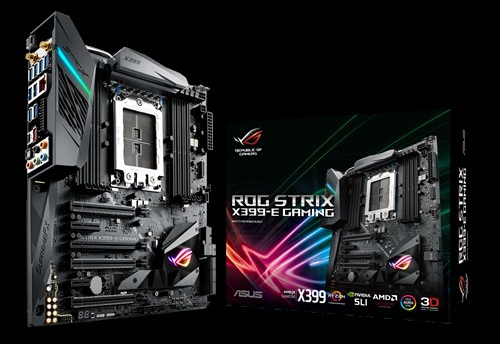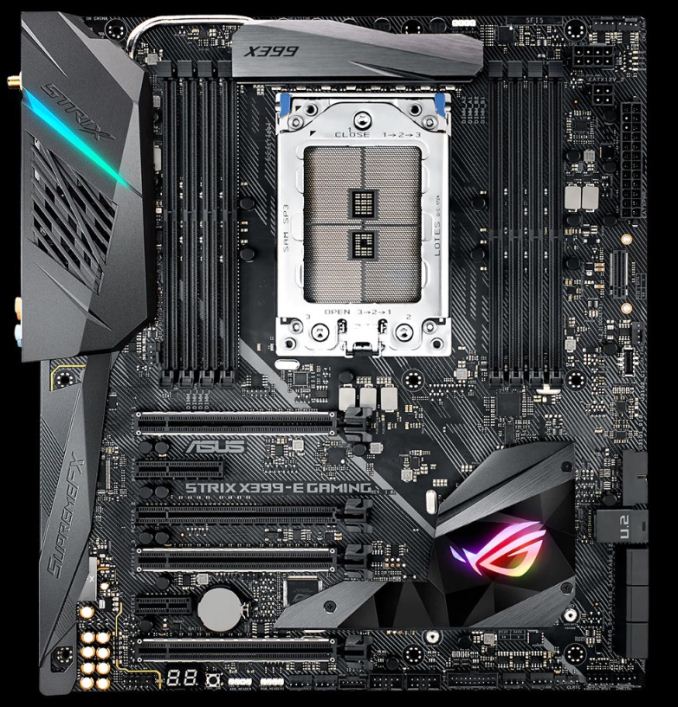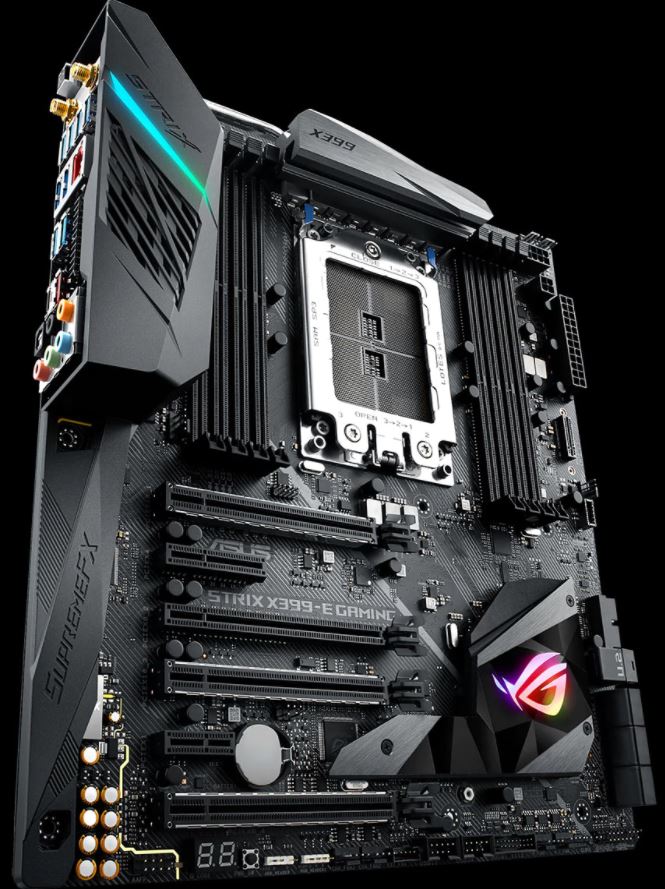An AMD Threadripper X399 Motherboard Overview: A Quick Look at Seven Products
by Ian Cutress & Joe Shields on September 15, 2017 9:00 AM ESTASUS ROG Strix X399-E Gaming
With the advent of eSports and the ability to stream and even broadcast your own gaming sessions, PC gaming has gained a significant amount of momentum the past few years. So much so, many (if not all) of the motherboard partners have latched on to the nomenclature and started entire lines for 'gaming' motherboards. ASUS is no different with gaming based motherboards, out for generations now under the ROG name, and continues to do so on the X399 Threadripper platform in the ROG Strix X399-E Gaming. Strix as a brand has migrated from a 'zero-noise' implementation to the more budget oriented gaming products from ASUS.
The ROG Strix falls between the Zenith Extreme and the Prime with a mix of features. For example, the Strix includes WiFi and Bluetooth connectivity, like the flagship Zenith Extreme, or that the Prime and Strix each have a single Intel I211-AT Gigabit LAN while the Zenith has three network ports including a 10 GbE. The Strix X399-E Gaming has eight DRAM slots, supports multiple GPUs (SLI and Crossfire), uses the latest audio codec (Supreme FX S1220A for the Strix), a capable VRM, multiple storage options, and RGB lighting among other features.
Looking over the board in detail, we'll start at the top. First, the VRM configuration is an eight-phase design. It is cooled by dual heat sinks running along the top of the socket with the second sitting between the memory slots and rear I/O. Extra cooling on the VRMs is provided by an included 40mm fan sitting under the I/O shroud (similar to the Zenith). Both EPS connectors, an 8-pin and 4-pin, as well as the 24-pin ATX connector, are in the top right-hand corner of the board. Below that is the second M.2 slot. An M.2 drive in this slot, like in the Prime, sticks out from the board instead of laying flat. ASUS does include an M.2 bracket for the slot to assist with supporting the standing device.
Continuing to move down the motherboard, below the vertical M.2 slot is the USB3.1 (10 Gbps) header fed from the chipset. For cases that have front panel USB 3.1 ports, this is typically the header used for that connectivity. Below that is the single U.2 port and six SATA ports.
The chipset heatsink on the ROG Strix houses RGB LEDs that can be adjusted with the AURA Sync software. The only other LEDs on the board are located on the I/O cover. The chipset heatsink extends on the bottom between the last two full-length PCIe slots and covers the first M.2 slot providing additional cooling for those devices.
The Strix offers four full-length PCIe slots, three use a reinforcing guard and is where users will slot their graphics cards for optimal performance. The PCIe arrangement allows for up to a triple slot video card between slot 1 and slot 3, and a dual slot card will fit between between slot 3 and slot 4. Slot breakdowns are x16 for single, x16/x16 for dual GPUs, and x16/x16/x8 when using three GPUs. Additionally there is one PCIe x1 slot, a PCIe x4 slot, and full-length PCIe slot (x4). These slots distinguish themselves by not having the reinforcement.
Across the bottom of the board are more onboard headers. These include external addressable RGB LED headers, fan headers, and USB3.0 headers. It also has a debug display as well as a small power button for testing outside of the case. On the left side of the board is where the audio parts are housed. Mostly concealed under the shroud is an EMI protected ALC1220A codec using upgraded filter caps, and PCB separation of the audio components from the rest of the board.
The rear I/O panel is fairly busy with a BIOS reset button, wireless connectivity, eight USB 3.0 ports, and the Gigabit Ethernet port taking up most of the real estate. USB 3.1 Type-A and Type-C ports from the ASMedia controller are also present, with the audio jacks, including SPDIF output, rounding out the rear panel.
| ASUS ROG Strix X399-E Gaming | |
| Warranty Period | 3 Years |
| Product Page | Link |
| Price | N/A |
| Size | ATX |
| CPU Interface | TR4 |
| Chipset | AMD X399 |
| Memory Slots (DDR4) | Eight DDR4 Supporting 128GB Quad Channel Up to 4133 MHz (OC) |
| Network Connectivity | 1 x Intel I211-AT GbE |
| Wireless Network | Wi-Fi 802.11 a/b/g/n/ac |
| Onboard Audio | SupremeFX S1220A |
| PCIe Slots for Graphics (from CPU) | 4 x PCIe 3.0 x16 Supports SLI/CF |
| PCIe Slots for Other (from Chipset) | 1 x PCIe 2.0 x4 (max) 1 x PCIe 2.0 x1 |
| Onboard SATA | 6x Supporting RAID 0/1/10 |
| Onboard SATA Express | None |
| Onboard M.2 | 2 x PCIe 3.0 x4 - PCIe or SATA |
| Onboard U.2 | 1 x PCIe 3.0 x4 |
| USB 3.1 | 1 x Header 1 x Rear Panel Type-A 1 x Rear Panel Type-C |
| USB 3.0 | 8 x Rear-Panel 2 x Header |
| USB 2.0 | 2 x Header |
| Power Connectors | 1 x 24-pin EATX 1 x 8-pin ATX 12V 1 x 4-pin ATX 12V |
| Fan Headers | 1 x M.2 1 x CPU 1 x CPU OPT 3 x Chassis 1 x AIO_PUMP 1 X w_PUMP+ 1 x 5-pin EXT_FAN |
| IO Panel | 1 x Intel NIC 1 x USB 3.1 Type-A 1 x USB 3.1 Type-C 8 x USB 3.0 1 x Optical S/PDIF out 5 x Audio jacks 1 x USB BIOS Flashback Button 1 x 2x2 Wi-Fi 802.11 a/b/g/n/ac |
ASUS mentioned pricing for the Strix X399-E Gaming to be at a more affordable price than their flaghsip ROG Zenith Extreme. It is currently available through smaller distributors, perhaps as a pre-order, but not found on Newegg or Amazon at the time of writing (9/11).













99 Comments
View All Comments
vgray35@hotmail.com - Saturday, September 16, 2017 - link
A few % better - you are looking at it wrong. Platinum PSU units with peak 94% efficiency means 6% heat dissipated. Now at 99% efficiency that is 1% dissipated as heat. That means a 5/6th reduction in heat or 83% less heat which is not just a few percent better. Further the new topology yields a >70% cost reduction which is also not insignificant. Gas turbines are also too noisy by the way, which is the main reason these are not considered (expensive when they go wrong too), and thus not a good comparison versus improvements being discussed here. Are you saying the linked article on PWM-resonance and resonance scaling topology is not worthwhile, or the problems with Buck converter inductors is not a severely limited and highly noisy power solution? Perhaps Power Electronics engineering is not your field of interest at all!Manch - Monday, September 18, 2017 - link
ICE is not 60% less efficient than a gas turbine. A gas turbine doesn't scale downward well. One of similar power would actually less efficient as an equivalent rated ICE. Gas turbines are impractical for vehicles.One benefit of a turbine would be no tailgating. The intake would suck in and crap out small critters all over your windshield.
vgray35@hotmail.com - Friday, September 15, 2017 - link
Yes I appreciate that - we draw power (Watts) at the rate of Joules of energy per second, Notice I said "we draw power", but that is also directly reflected proportionally as current in Amps (or a rate of Coulombs per sec), There was not a direct inference that power is measured in Amps, but only (a) "We are drawing a measure of power", and (b) this is approaching proportionally a resultant 150A. Yes I probably could have said better, but in wise did I say power is measured in AMPS.vgray35@hotmail.com - Friday, September 15, 2017 - link
I do not believe a defacto motto of the industry is "we are wasting 5% in heat, so let us not bother with wasting only 1%). Clearly you did not read the link to the Power Electronics article (I surmise), as then you would have realized the solution offers a huge reduction in cost as well as heat. The cost factor is something everybody is interesting in, even the industry at large, in my humble opinion.ddriver - Friday, September 15, 2017 - link
Huge? Like what? 6-7% better? Maybe 8-9%?What I meant is the solution you linked to is like 99% efficient, a good buck converter is what? Like 90-92%?
That's nowhere near the difference between an internal combustion engine and a gas turbine, the latter being more than twice more efficient. And still no adoption, even thou the solution is not really all that complex, and decades old. They still only use gas turbines in the most demanding applications, which is pretty much the same as with the converters from that article, which that dude developed for NASA's most demanding applications. I am pretty sure computers in NASA run on buck converters too, and they will use his designs only for the stuff they launch into space.
You probably don't realize how immense of an impact it would have if all cars on the planet become more than twice as efficient, burning more than twice as little fuel, outputting less than half the harmful emissions, traveling twice as far on a single fill. It would completely dwarf the benefits of boosting computer power converters from 90 to 99% :)
I am not saying it is not cool, I am just saying there have been a lot more beneficial a lot more high priority solutions that haven't been adopted yet for a lot longer, so you should not be surprised that the entire industry hasn't switched to a new power converter design overnight. They will do as they will always do, they will milk the cow until it dies, and then make it into jerky, and only then will then go for the new and better thing.
vgray35@hotmail.com - Saturday, September 16, 2017 - link
As noted earlier, 92% which is 8% heat versus 99% which is 1% heat means a 7/8th reduction in heat or 87% reduction. Thinking this is only a 7% improvement differential is incorrect - it is in this example an 87% improvement. That is not small potatoes. When this is coupled with a corresponding large cost reduction, then it becomes apparent the chip manufacturers would rather make more money using the older technology. Maybe the PSU engineers are just plain lazy or are not following the advances in their field as they are snowed under with work.Let's keep the discussion focused on power supplies.vgray35@hotmail.com - Saturday, September 16, 2017 - link
The 600W @ 12V fed to the motherboard with ~8% losses is ~50W heat in the VRMs (driving 180W CPU, 320W GPU, leaving 100W for other parts), The ATX power supply is 90% efficient or less with 60W heat also in the same case. The GPU power supply also is another 25W waste power supply heat, for a total of 135W of waste heat (as opposed to the useful heat generated within the various components themselves, which is heat generated from useful work being done). It is tough to manage this 660W in the case, but over 135W of it (>21% low ball estimate) is waste heat from just power supplies alone (ATX PSU, VRMs, GPU supply), of which over 80% or 110W could be eliminated by abandoning the Buck converter topology. This of course is a simplistic view, as there are other components too that are ignored here, for brevity's sake. I suspect >25% of heat comes from power supplies alone which can be dramatically curtailed. It's a 3 ringed circus: ATX PSU steals 10% for itself, motherboard steals another 8% for itself and GPU steals a further 8% for itself. We have no control over the power drawn from the mega chips themselves, but we do have control over the power supplies that drive them, and manufacturers could be doing a lot better here. And this is by no means a monster power hungry system with only one high-end graphics card. A >85% reduction in power supply waste heat can be realized if the Buck converter is abandoned, and that applies to resonant LLC power supplies also. The motherboard manufacturers and ATX PSU manufacturers need to take this aspect much more seriously.http://www.powerelectronics.com/power-management/s...
AMD's Thread Ripper X399 and Intel's X299 platforms should have been their first attempt at abandoning the Buck, half-bridge, and resonant LLC topologies. They failed us in that regard. We need this fiasco to come to an end by using hybrid PWM-resonant switching and resonance scaling, which eliminates the ferrite cored inductors altogether, and replaces them with just copper traces on the PCB. This is not rocket science.
Oxford Guy - Saturday, September 16, 2017 - link
Motherboard makers seem pretty much incompetent. They can't even be bothered to issue BIOS updates to fix serious bugs.ddriver - Sunday, September 17, 2017 - link
Yeah, but then again, an overclocked TR is like 200W, even an entry level car is like 200 KILOWATTS. So percentages are not really that much indicative.The facts remain. A TR mobo with a better power regulator circuit will save like 10 watts of power, a car with a gas turbine engine will save like 100 KW of power.
That's 10 000 times larger saving measured on absolute scales. What's more important in your opinion? Saving a watt, or saving 10 000 watts? Naturally, I'd rather have both. The goal here is to illustrate how low of a priority it is to improve mobo power delivery compared to some other, longer standing improvement opportunities that have been ignored.
Icehawk - Sunday, September 17, 2017 - link
They tried turbine cars, they are terrible due to the way they deliver power. Several successful drag cars have used them as in that application the power delivery works well. Same reason we aren't going to be driving rocket cars.